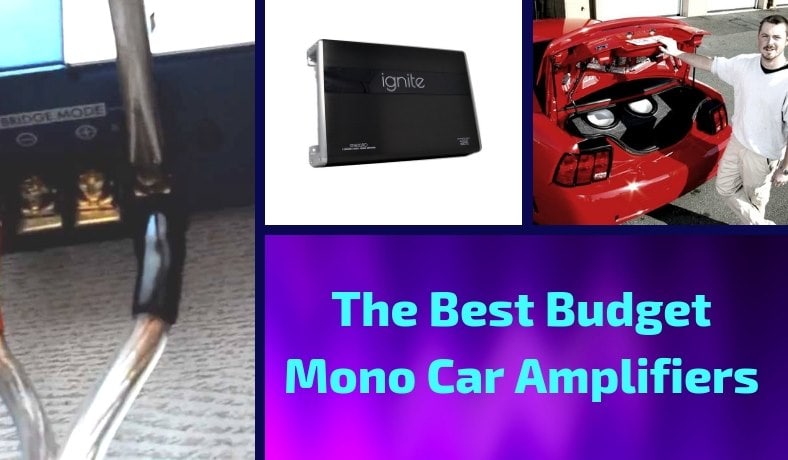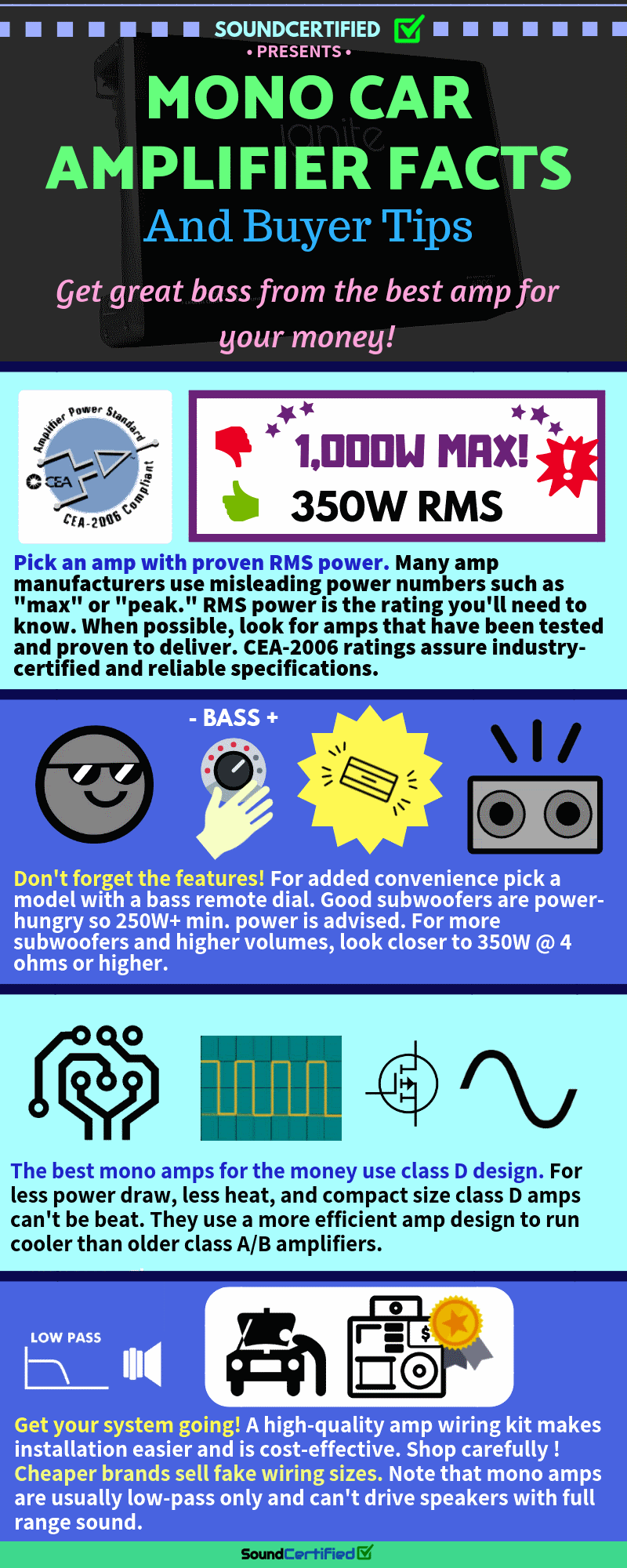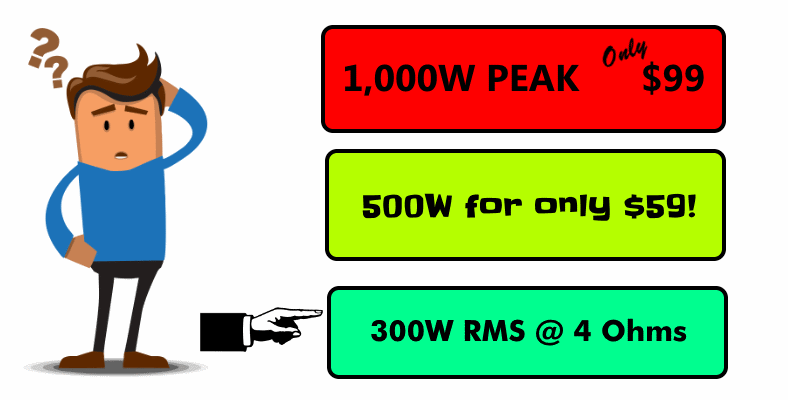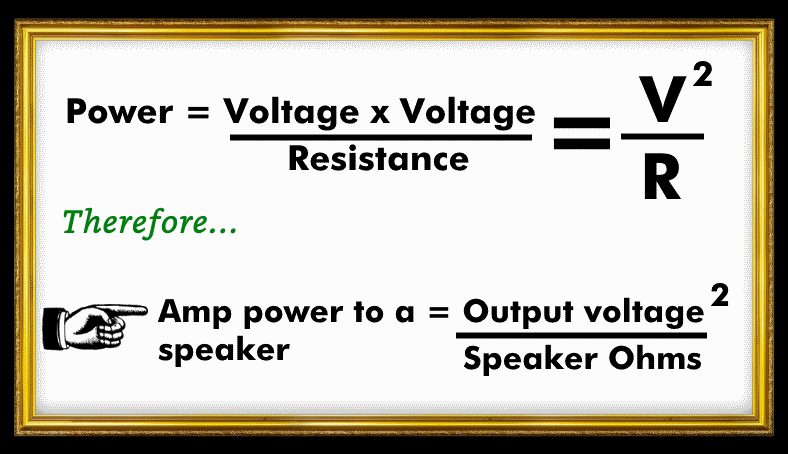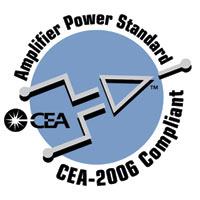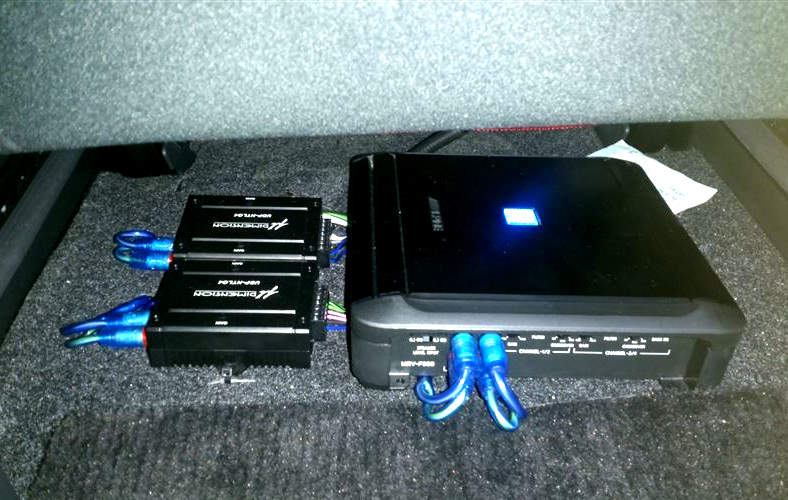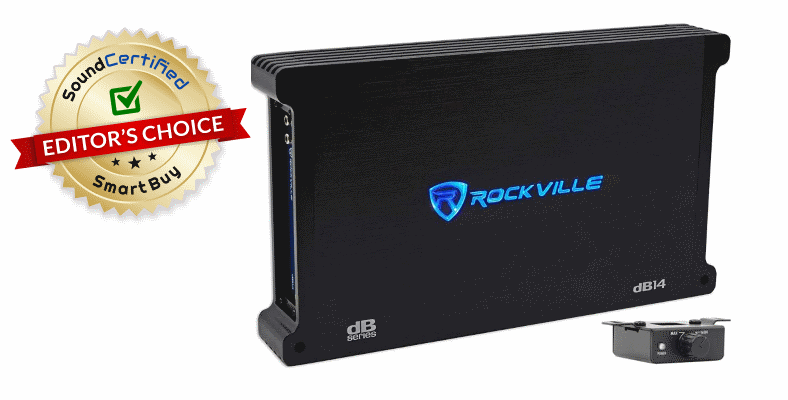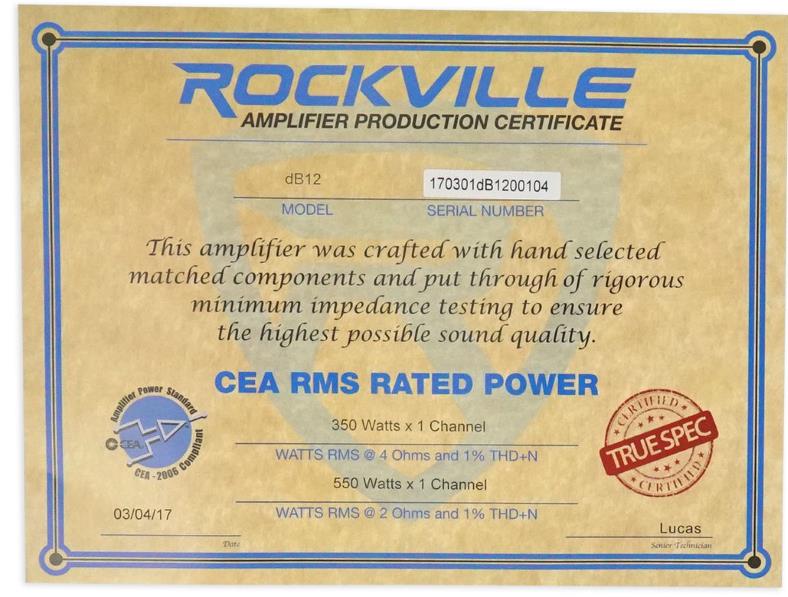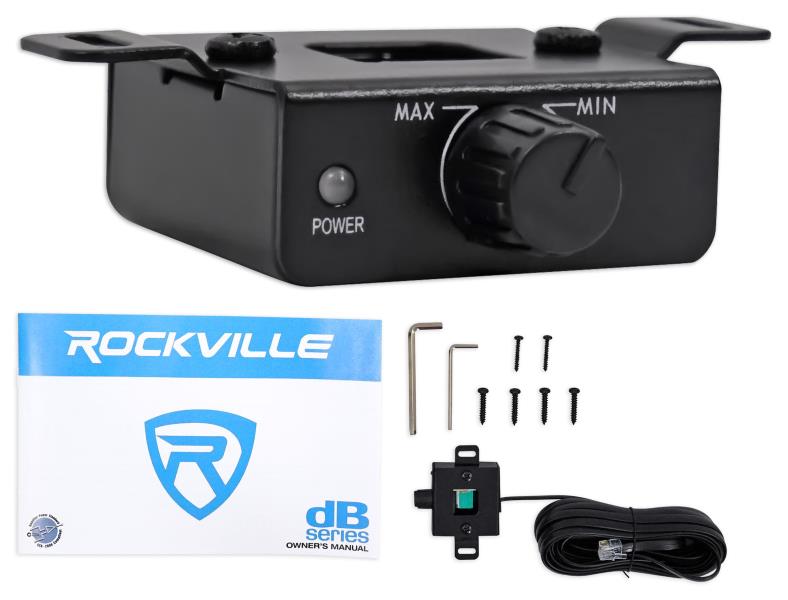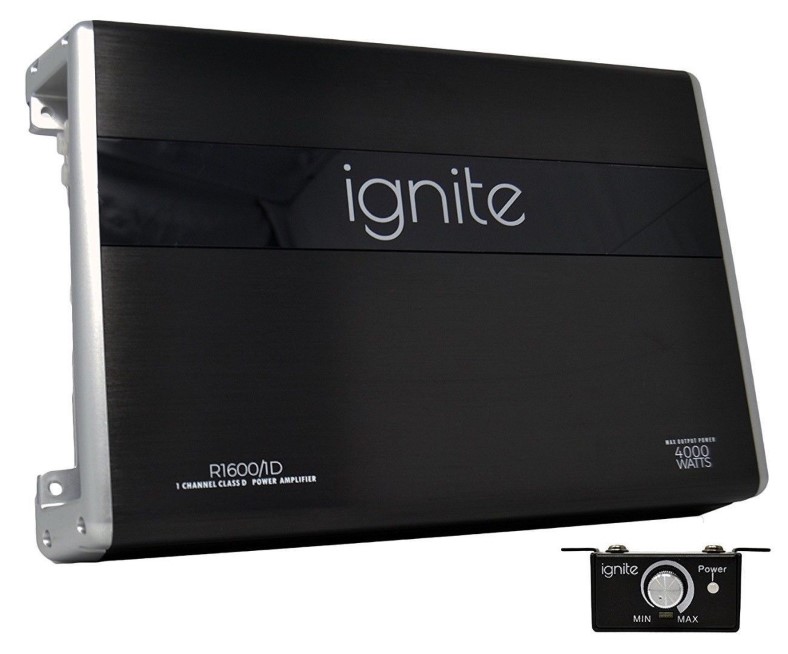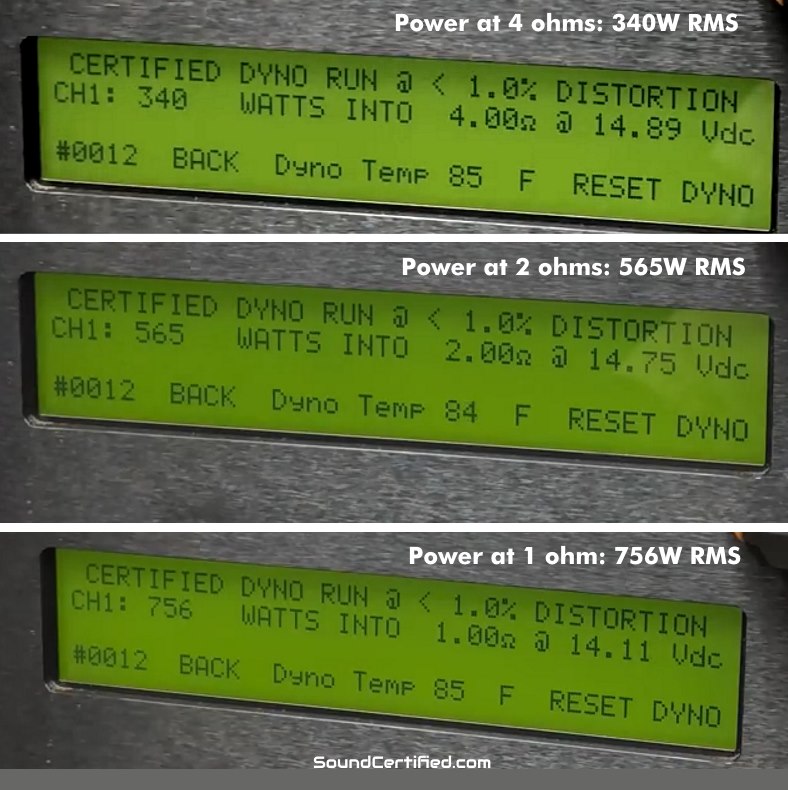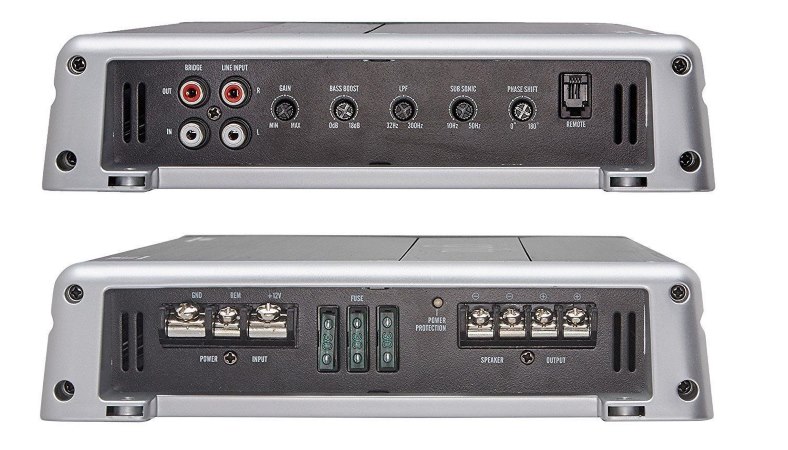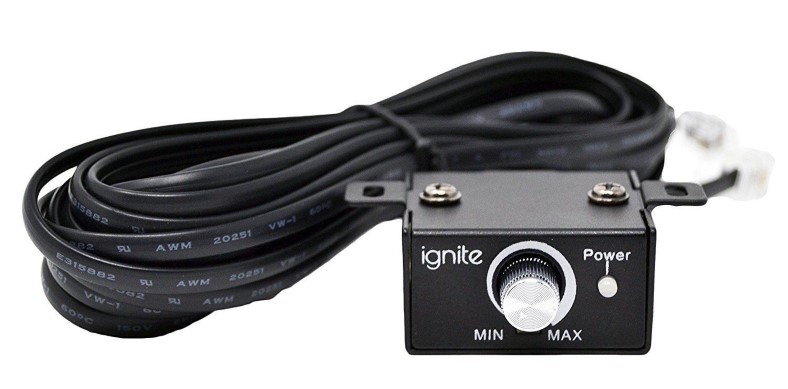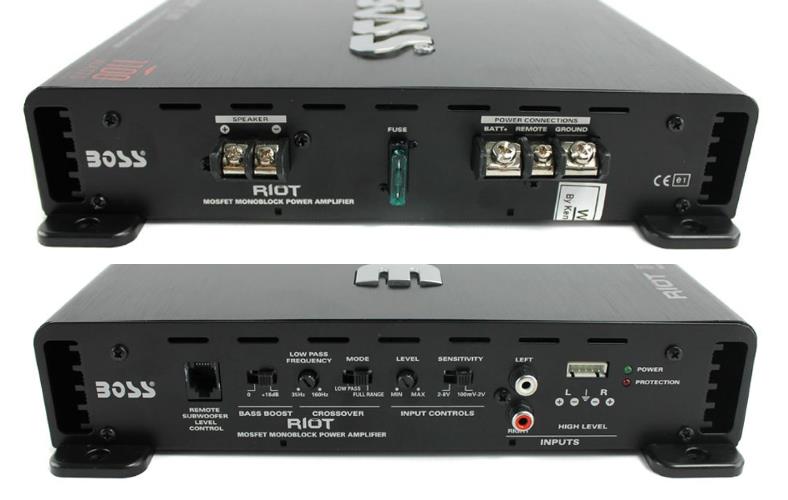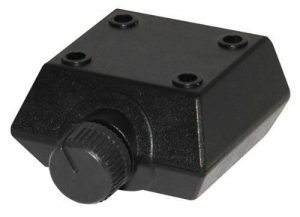Just want to put some great bass in your ride but trying to figure which amp is worth the money? There are so many to choose from that it starts to become a hassle.
To make matters worse, many manufacturers use misleading power specs that aren’t true. Pick the wrong amp and you’ll get weak, distorted bass when you crank the volume (not to mention having wasted your hard-earned money!)
In this post you’ll find some excellent mono bass amps you can afford under $100. Each one has proven power ratings, great sound, and you’ll get that amazing bass you love.
Contents
Infographic – Mono car amp facts and buyer tips
Watch out! Fake power ratings and what to know
Car amp power ratings can be amazingly confusing. So many just don’t seem to add up, and so many are misleading. What’s correct and what isn’t?
Shopping for a bass mono car amplifier? Then you’ve very likely already seen how confusing it is to shop and try to figure out all the power ratings listed on websites and by the manufacturers.
Unfortunately, this has been going on for many years. Some manufacturers rely on a buyer’s lack of understanding as well as misleading numbers to sell amps based on false advertising.
To make matters worse, even if the numbers are reasonable (for example, you’re not going to get a 1,000W amp for $99!) sometimes they’re still not correct.
Car amplifier power ratings explained
First and foremost, there is generally one basic power rating you should look for when shopping: Root Mean Square (RMS) or continuous power. Because amplifiers produce output a waveform to make music (and not a flat DC voltage like you’d see from your car battery) it’s a bit complicated.
RMS power is an engineering term that represents the actual amount of energy (power) an amplifier will deliver at a specific battery voltage.
Sadly, terms like “peak” and “maximum” power are used misleadingly all too often to sell car amps.
The problem is, peak power doesn’t correctly describe how much power an amplifier will actually deliver constantly. It’s a number or set of numbers based strictly on the mathematical computation and what can be delivered for a split second – not what’s actually useable and will drive speakers constantly.
In other words, RMS or continuous power ratings are used to describe the actual amount of real power an amp can deliver to a speaker load.
“Peak” and “maximum” shouldn’t be relied upon to make a buying decision.
Who even knows what some car amps can really produce when put to the test, without stress testing them?
Standard testing & CEA-2006 industry standards
Because of the enormous problem with misleading specifications in the car stereo world, the Consumer Electronics Association (CEA) 2006 standards were created.
It’s a voluntary way for standardized, reliable tests to be made and prove that a manufacturer’s car amplifiers and other products will deliver what they advertise.
Typically for an amplifier, a standard battery power voltage of 14.4 volts is used when measuring power output at a specific load like 4 ohms or 2 ohms.
When shopping, your best bet is to choose an amplifier with proven lab test results or CEA-2006 compliant specs, meaning they’re true ratings and you’ll get what you’re paying for.
What is a “class D” mono bass car amp?

Class D mono car amps use modern high-speed switching circuits and chips to represent the input musical signal as square waves. These then drive power transistors that never remain fully switched on like older designs. This in turn reduces power use as less electrical current flows.
The amplifier square waves are then converted back to a smooth musical signal and output to your subwoofers, creating powerful sound.
Sometimes you might hear the term “digital” used to describe class D amps but it’s not correct.
These types of amps don’t convert the input signal (analog) to a digital signal. It’s simply used to turn transistors on and off for longer or shorter periods of time depending upon the music signal.
Class D mono car amplifier advantages
Because they’re so efficient and generate less heat, class D amps are smaller and are more easily installed in limited space. Many can fit easily underneath seats and open new installation possibilities. This was often impossible with high power class A/B amps which required large metal heat sinks to stay cool.
The great thing is that it’s an excellent technology for mono amps.
Although class D amps typically have lower signal-to-noise (SNR) ratings than less efficient types, for bass that’s not really a problem. In most cases, it’s far harder to notice distortion and SNR differences when driving subwoofers.
Advantages provided are:
- They give much more power in a lower price range
- Produce far less heat and run cool
- Are smaller and easier to install
Additionally, the technology has improved greatly, making these types of amps a lot better value than their similar class A/B counterparts.
Class D mono amps typically have around 82-84% efficiency vs class A/B with only 65%, and often 50% and less!
Mono amps vs full range amps: pros and cons
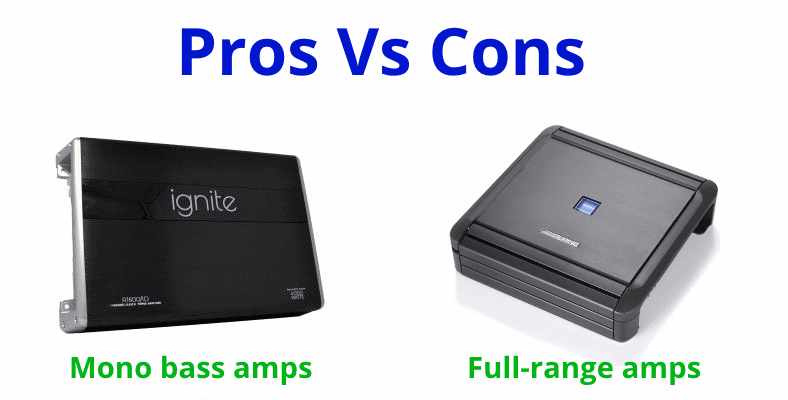
Mono amps normally are designed only to drive subwoofers and cannot be used for full range speakers in most cases.
They’re also designed to deliver more power for the dollar than full-range amps. While full range amplifiers can be bridged to deliver more power, it’s usually still a lot less than a good budget mono amp provides.
Full range amps also have more flexible crossovers which allow more system control, while mono bass amps have a much more limited low pass crossover. Some also feature a bass boost switch or level to enhance bass production.
★ The best budget mono car amplifiers under $100 ★
Our top picks for the money
| Image | Product | Details | |
|---|---|---|---|
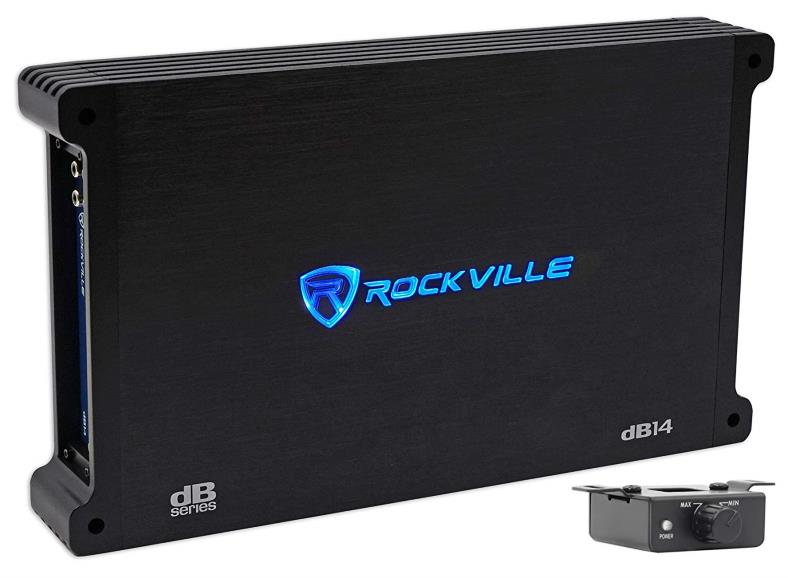 | BUDGET BEAST!Rockville DB12 Class D |
| Check on Amazon |
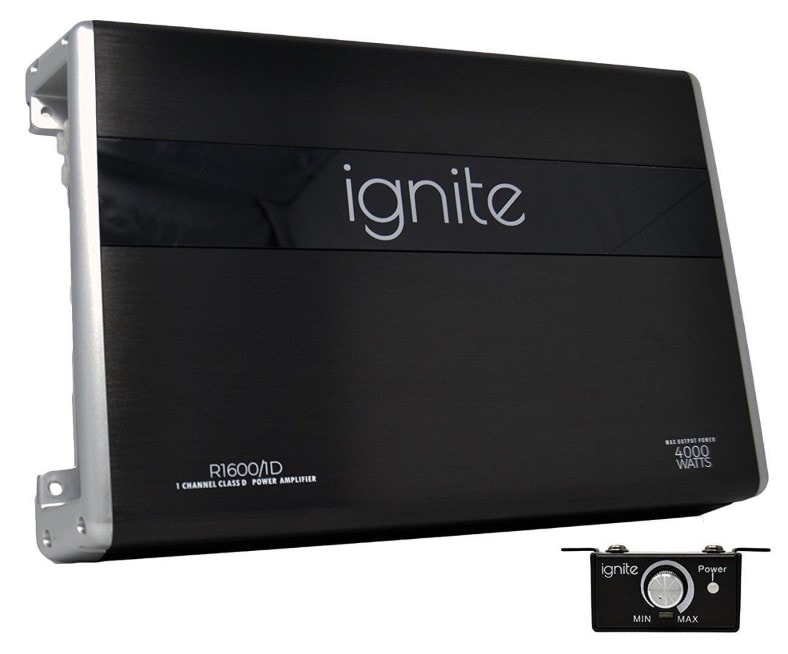 | Ignite R1600/1D Class D |
| Check on Amazon |
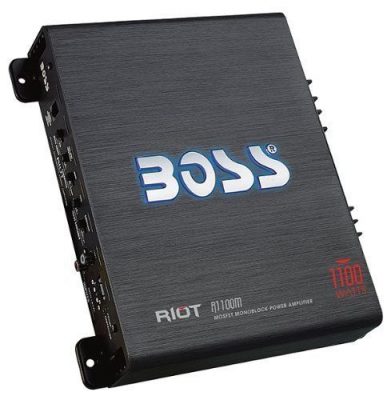 | Best SellerBoss Riot R1100M |
| Check on Amazon |
Reviews, power details, and pros/cons
1. Rockville DB12 – A budget beast! Fantastic CERTIFIED power and features for under $100.
Ready for some surprising budget power? The Rockville DB12 is one of the best hidden budget steals you’ll find today.
For starters, unlike most of the other budget mono amps out there, Rockville provides industry-standard CEA-2006 power specs with proven numbers! It’s also lab-tested to actually slightly exceed its rated power.
Power ratings are:
- 350W RMS @ 4 ohms
- 550W RMS @ 2 ohms
That’s some serious power for an amp that you can find for under $100 if you shop carefully (see my link below). Not only that, but it’s well-made and the features are surprisingly good, too.
(CLICK IMAGE TO ENLARGE)
Unheard of in budget amps, the DB12 includes a certificate of verified power. You won’t find that elsewhere, and it’s a fantastic thing in my opinion. CEA RMS rated power means you’re guaranteed to get an amp that delivers as promised.
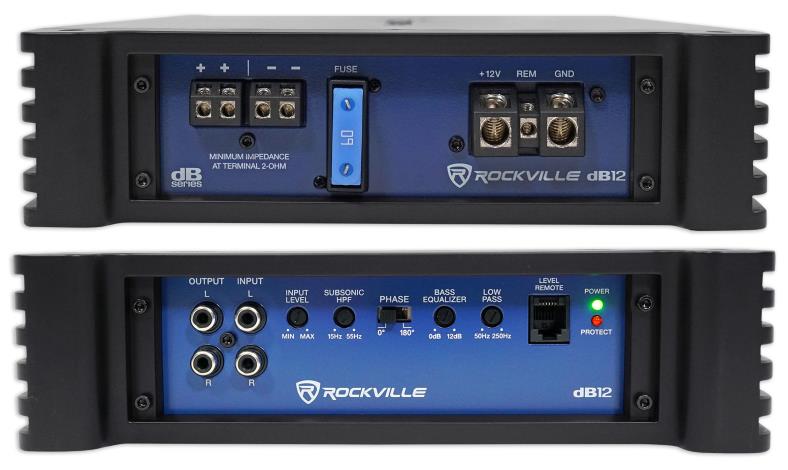
What really surprised me about the Rockville DB12 isn’t the amount of power you get for the price, even though that’s pretty fantastic. It’s the features that really put it head and shoulders above the rest.
You’ll get all of this, too:
- Includes bass remote and cable
- High-current wiring terminals
- Certification sheet with tested power and serial number
- RCA line out jacks for expansion
- 0/180° sub phase control switch
- Subsonic filter
- Bass EQ feature
- 0-250Hz adjustable low pass filter
- Soft on & mute start up circuits
- Overheating and short-circuit protection
- LED illuminated logo
- Bass remote features a power LED
You’re simply not going to top this list of features an anything else I’ve seen in price range. Without a doubt it’s one of the rare few to offer true CEA-2006 power ratings.
Included with the DB12 is everything you’ll need to get started aside from the wiring kit and a signal source: Allen wrenches for the speaker terminals, mounting screws for both the amp and remote, an owner’s manual, and the remote + easy-connect cable.
Is it perfect? Certainly not. I do have a few complaints.
Mainly, it can’t handle 1 ohm speakers so you can’t drive some subwoofer setups like other amps. Additionally, if connecting to a factory system you’ll need an RCA speaker level converter as speaker level inputs aren’t provided.
Regardless, in my opinion, it’s hands down an amazing budget beast that’s well put together and is a fantastic value.
- CEA rated RMS power certificate
- Great power output (350W / 550W)
- Good build quality
- >90 dB SNR
- Includes bass remote dial
- Bass EQ feature
- Phase control switch (0/180°)
- RCA pass through jacks for system expansion
- Compact size (9″ x 2.4″ x 13.1″)
- LED illuminated logo looks great
- High-quality wiring terminals
- Sub-sonic filter
- Soft start and protection circuitry
- Adjustable low-pass filter
- Can’t handle 1 ohm subwoofer loads
- No speaker level inputs
- 1 year warranty only
- Mounting screws are harder to install
The Rockville DB12 is an amp I thought I’d never be awarding my Editor’s Choice best value award to. However, I can’t argue with the facts: it’s an excellent budget bass powerhouse that’s affordable and ticks all the right boxes!
Get one before they’re gone! Head over and check out the latest sale price and get free shipping at Amazon.
2. Ignite R1600/1D – A true hidden gem. Lab proven power, great features, and low price.
The Ignite R1600/1D is a cool little gem of an amp you’ve likely never heard of. However, you’ll be glad you found it!
It’s an excellent budget mono bass amp with proven RMS power that EXCEEDS it’s ratings! That makes an already sweet deal even better. These are real, dyno-tested and proven tests – not just advertisement.
Additionally, unlike some other models such as the Rockville DB12, it’s stable to 1 ohm as well. This is a great little class D amp that puts out slamming bass while still running cool.
Rated vs lab-tested power ratings are:
- 4 ohms RMS: 300W rated, 356W tested
- 2 ohms RMS: 530W rated, 565W tested
- 1 ohm RMS: 750W rated, 756W tested
Yes, that’s nearly unbelievable but true! An incredible 756W of real, useable power in an amp that’s less than $100. It’s also a great-sounding amp too.
Lab-tested true power output results for the R1600/1D, as tested on an amp dyno (power and load testing machine). As you can see, at a bit above 14V (when the engine is revved higher) the power output actually exceeds the advertised ratings!
Lab-tested results from running the amp on a dyno a 4, 2, and 1 ohm loads show the R1600/1D and deliver some serious power. Unlike other budget amps, there are no misleading “peak” or “max” ratings to have to deal with.
Just some serious watts-per-dollar value.
Not to worry, though – you won’t be giving up features when you pick up the Ignite.
The R1600/1D is well-made and definitely not short on features. you’ll get a subsonic filter, adjustable bass boost, RCA line out jacks, phase control, low-pass adjustment, and bass remote port.
The features really got my attention as well. Unlike some of the low-priced competitors, you’ll still get some of the same options for better sound as more expensive models.
Features include:
- Includes bass remote dial and cable
- RCA pass through jacks for expansion
- 0-180° sub phase control dial (adjustable)
- Subsonic filter
- Bass boost dial
- 0-200Hz adjustable low pass filter
- Soft on & mute start circuits
- Overheating and short-circuit protection
- Uses standard ATC automotive fuses
- Remote includes power-on LED
I love bass remotes and the R1600/1D includes one at no extra charge. It’s easy to install and works well – just dial in the amount of bass you want from the convenience of your driver’s seat. There’s also a power-on indicator LED light included. Nice!
The bass remote (included at no extra charge) is great and works well. It’s an inexpensive – but good – knob-style dial with a connecting cable that easily snaps into jacks on both ends.
The included power status LED lets you know that the amp is powered on and running. Just dial in more or less bass anytime! It makes adjustment a lot less of a chore – no need to fiddle with the stereo anymore!
I do have a few minor complaints, of course: the mounting screws can be a bit harder to drive in when mounting as the mounting feet are located on the inside of the amp housing, instead of facing out.
Also, the wiring terminals aren’t as nice as those on competitors like the Rockville DB12. It’s also slightly larger in size as well. No speaker level inputs are provided either.
However, those are tiny gripes and barely worth mentioning when we’re talking about such a great budget beast of an amp.
- Excellent true RMS power: up 756W RMS
- Stable to 1 ohm
- Adjustable phase control (0-180°)
- Adjustable bass boost
- 0-200Hz adj. low pass
- RCA line out jacks
- Bass remote included
- Nice, sleek design and appearance
- Well-made
- Simple controls
- Mount screw holes a bit inconvenient
- No illuminated logo or lighting
- Distortion slightly higher than others
- Wiring terminals could be better
- Slightly larger than some competitors (13.66 x 2.05 x 8.94″)
- No speaker level inputs
The R1600/1D is the perfect choice for an entry-price system that sounds much more expensive than it is. It truly is a hidden budget gem that really delivers more for less money.
Don’t waste any more time shopping around.
Hurry and check out the R1600/1D now with free shipping at Amazon before they're gone.
3. Boss Riot R1100M – A SUPER popular cheap starter amp for tight budgets (Under $50!)
Think you simply can’t get a decent bass mono amp for less than $75? Guess what – here’s the answer!
The Boss Riot R1100M is a great super-affordable entry-level way to get good bass sound. It’s also one of THE best-selling budget subwoofer amps of all time.
I’ve included this one in my list because while it’s not high-end sound, for those who really can’t afford to spend more money it’s a great starter amp to get you going for now.
The R1100M, from the budget Riot line of class A/B amps, delivers some of the best value for the dollar. However, much like other budget models, the power ratings are misleading so here’s what you need to know.
Lab-tested power ratings for the R1100M are:
- 129W RMS x 1 @ 4 ohms
- 212W RMS x 1 @ 2 ohms
While it’s not enough to drive the biggest, most massive subwoofers around, it does well for budget systems where you don’t need expensive, high-dollar power.
Measuring a tiny 9.13″W x 10.44″L x 2.25″H in size it’s a great fit for both trucks and cars. The compact size fits in a lot of spaces other amps can’t (especially under a seat).
The features are actually pretty good for such a cheap amp:
- Wired remote bass level control with cable
- Soft turn-on (anti-thump)
- Speaker level inputs for factory stereos
- 3-way protection (thermal, overload, and speaker shorts)
- 102dB SNR (at rated power)
- Adjustable low-pass filter (35-160Hz cutoff)
- 0-18dB bass boost
Yes, it’s cheap! However, the R1100M is actually a pretty decent little amp – far better than you’d expect for something the reaches $50 and below when on sale! It’s well put together and the features are definitely great.
Unlike many competitors, it features speaker-level inputs and can work with factory systems with no other parts needed.
The included bass remote is the same as the bigger models in the Riot series of amps. Included is a telephone style cable which makes installation of the remote a snap – both ends just snap right into place. It’s a super-convenient feature that makes enjoy your subs even better.
It’s a great value as it also features a bass boost switch, low OR full-range crossover control, and the optional subwoofer remote is included.
I don’t normally recommend lower-price amps like this – especially those that don’t list the real RMS power ratings. However I can’t deny that it’s extremely popular for a good reason: it’s a good starter amp that’s incredibly affordable and has enough power for good, basic bass.
- Decent power for the price
- Good sound quality
- Includes bass remote knob
- Compact size
- Incredibly affordable
- 6 year warranty (through Amazon)
- Nice finish, illuminated logo
- Speaker level inputs
- Full-range capable
- Adjustable low-pass crossover
- Bass boost feature (+18dB)
- Simple connections
- No Allen wrench needed for terminals
- Great buyer reviews
- Not efficient like class D models
- No phase control
- Limited power
- Single pair speaker terminal
- Not 1 Ohm stable
- No RCA passthrough jacks
- Cannot chain like larger models
- Wiring terminals could be better
You’re definitely not going to get serious power like with models twice its price, but the Boss R1100M makes a fantastic super-low price entry-level model.
Head over and see the current super-low price and thousands of happy buyers at Amazon.
A great budget amp wiring kit
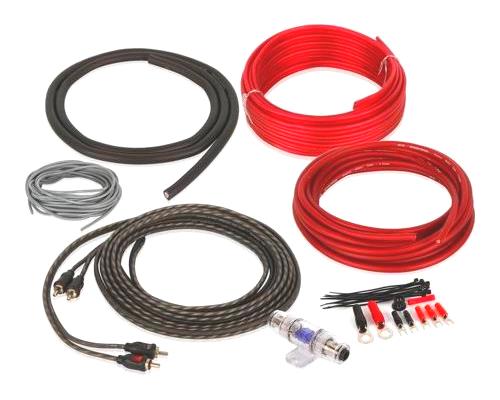
Don’t forget that high-power amps draw large amounts of current (high amps) and need good wiring and good connectors. You can get a great deal on a budget amp kit if you shop carefully and will avoid getting ripped off with cheap wiring.
The Belva BAK82 kit shown above is a high-quality option I recommend. It looks very professional when installed, too!
